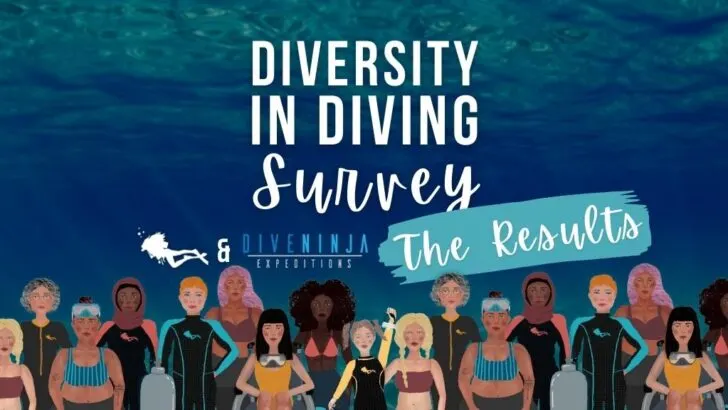Earlier this year, we ran a survey investigating the diversity of women in scuba diving. After receiving an incredible response, the results are in. We can’t wait to share them with you, and to influence change for women in the dive industry!
Why did we create this survey?
We designed this survey to gain a better understanding of what the diversity of women and non-binary people in scuba diving looks like. There’s a lack of usable data on the scuba industry in general, never mind information which is specific to women.
We already know there’s a gender imbalance in the dive industry – it’s partly why Girls that Scuba exists! This is well documented, with PADI data demonstrating that in 2021 only 37% of new divers were women. From other non-agency specific information, roughly 39% of new divers in the US are women.
We wanted to understand that on a deeper level, and dig into why this gap exists. In this article looking at the socio-demographic profile of scuba divers, it’s mentioned that “We need to better appreciate what keeps women away from scuba diving if we want to overcome that gap.”
This is precisely what we were trying to achieve with this survey. We wanted to learn what barriers have prevented women divers from progressing further in their scuba diving careers.
We hope that sharing this information will give a better picture of what the dive industry looks like for women and femme-presenting people. Making this information available also gives a better understanding of what challenges women face in the dive world. We hope that this can be used for the industry to make meaningful changes!
We’d like to thank…
Thanks to our incredible community, we received over 1000 responses to this survey! Such a wide range of answers means that we can really see an overview of what the dive industry looks like for women. We’d like to extend a huge thank you to anyone who took the time to respond.
We’d also like to say thank you to Dive Ninjas for their support in this project, and for bringing the inspiration to us to explore this further. Another big thank you goes to our past Girls that Scuba Ambassador, Alexa Fernando, who played a big part in the early stages of this survey.
Diversity of Women in Diving Results
Let’s get stuck into what you’re all here for – the results! We’ve looked into the information from the responses and broken it down into different sections to make it easier to digest. Here’s what we found out about the diversity of women in diving.
These results come from 1121 respondents. Responses were collected between December 2022 and January 2023.
Overview
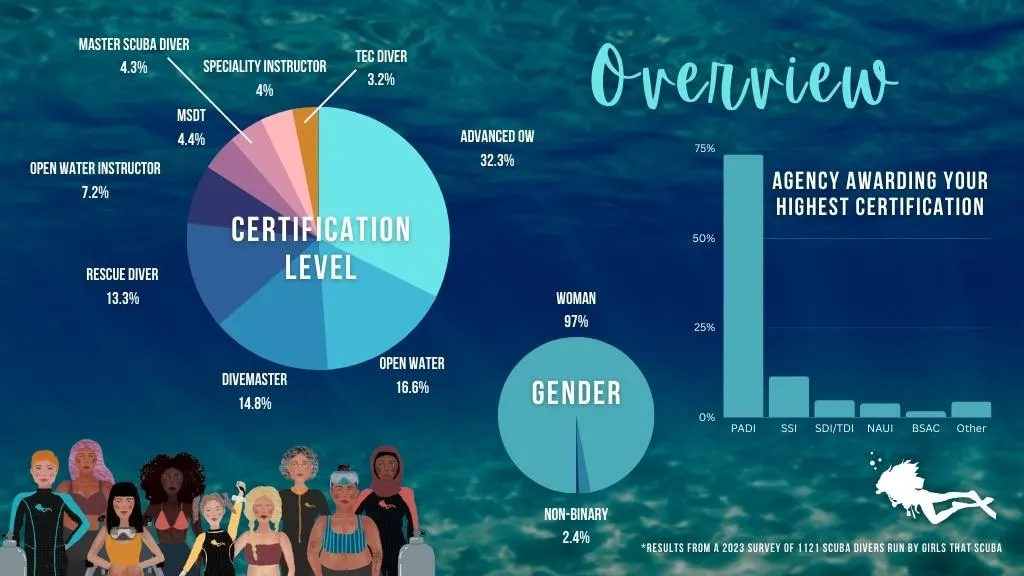
97% of divers who completed this survey identify as women (including 0.5% transgender women), 2% as non-binary and 1% prefer not to say.
When asked about their certifications, 31% said their highest certification is Advanced Open Water. PADI was the most common certification agency, with 74% of respondents’ highest certification coming from PADI.
The majority of participants fell into the 31-35 age category, at 22%. Ages 16-20 and 46-50 are equally underrepresented among women divers, at only 5% of overall participants.
When asked about their ethnicity, 71% identified as white. Only 1% of respondents were Black or African American. Many women were multiracial or biracial, at 10%. The next largest group are Asian women divers, representing 9%.
Career
29% of divers who completed this survey say it’s their goal to become a professional diver. 44% said they had considered it but decided it’s not for them. This suggests there are many women who are discouraged from pursuing careers in diving. Of those considering becoming professional divers, 26% want to complete their technical diving certification next.
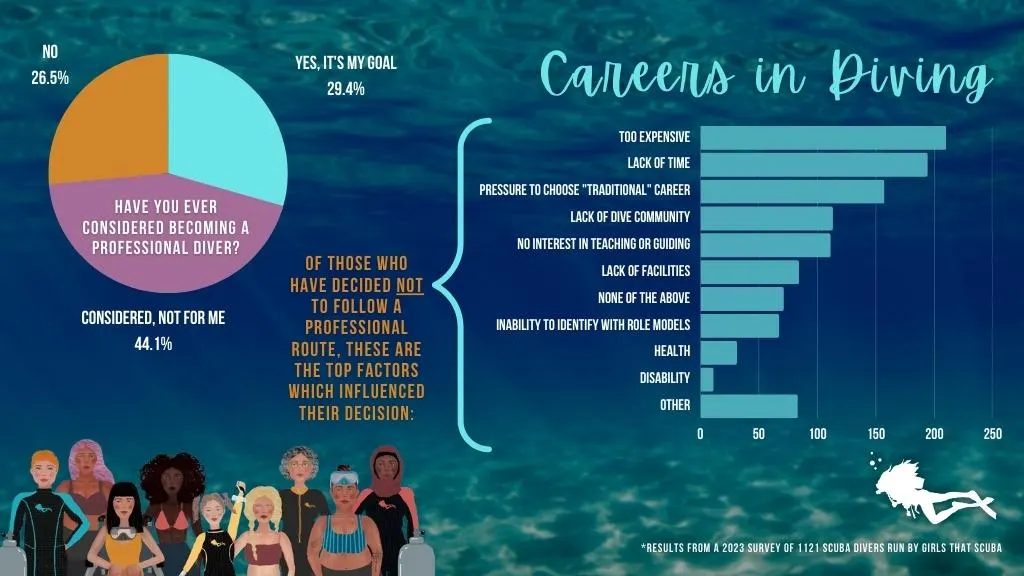
7% of respondents identifying as Black or African American are professional scuba divers (DM or above) compared to 29.3% of respondents identifying as White or Caucasian. This suggests more efforts need to be made to encourage Black women to progress in scuba diving careers.
25% of Asian respondents are professional divers.
Of the 44% of respondents who had considered a career in diving but decided not to, a majority of those quoted money, time and lack of accessibility and representation as a factor. Some actions they felt could help divers progress down a professional route are:
In areas with a thriving recreational diving industry, pay the dive master living wages, i.e. not relying on tips, with a reasonable apprenticeship. Diving is already a very expensive and high-risk sport, so it is hard for the customers to understand why the money did not reach the workers.
Affordable apprenticeship programs that can be done part time even if it takes longer to finish
Affordable courses, higher salaries, permanent contracts, social security
Ease of finding safe affordable housing would be one, providing strong health care coverage, good vacation time, and a better salary would be some.
Money
Amongst all respondents, the majority earn between $20,001 – $60,000, with 31% of women divers surveyed falling into this bracket. The second highest household income was those earning more than $100,001 per year, at 28%. 23% of those surveyed earn between $60,001 and $100,000, and those earning less than $20,000 had the lowest representation, with 18% of divers in this category.
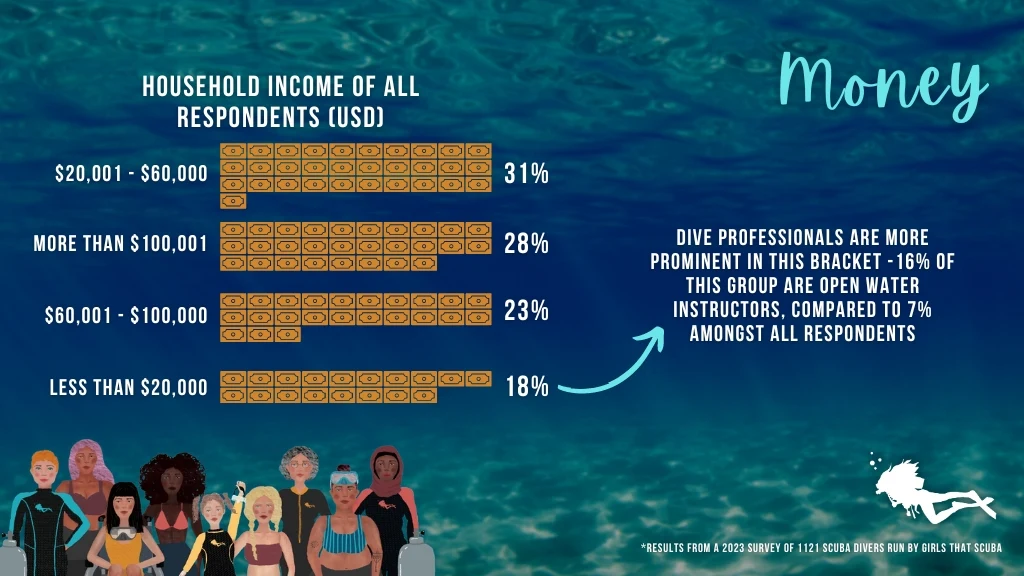
Amongst the respondents who are professional scuba divers, the majority (34%) have an annual income between $20,000-$60,000 USD. However, 43% of all Open Water Instructors surveyed have an annual household income less than $20,000 USD.
It’s important to note, though, that the value of a $20,000 USD salary can vary greatly depending on the cost of living where the instructors are teaching. This survey was conducted worldwide, meaning that this salary value can vary. You can read more about the impact of this in our post about changes women would like to see in the dive world.
Of the 28% of divers with an annual household income of over $100,000 USD, 73% were white, 7% Asian and 3% Black. (In comparison to total representation in the survey, only 1% off all respondents that completed this survey identified as Black or African American and 9% as Asian).
Additionally, 40% of respondents with an income of $20,000 or less are hoping to progress to the next dive certification but don’t know when. Many of the responses suggest that cost of certification, diving and equipment are their main barriers to progressing further in diving.
Some suggestions from respondents on how to help with the financial strain on becoming a professional diver are:
Dive shop/stores should offer diving equipment packages to student[s] to help make the sport more accessible.
Free classes for underrepresented people, scholarships or grant offerings, local meet ups or chapters for women that dive, events to attend, free classes on sea life.
Gender
Of the 2% non-binary divers who participated, over half of them lived in the USA. Those who have not progressed into higher certifications have spoken about barriers such as:
Financial and transphobia, racism, ableism, sexism, and classism I’ve experienced in the dive community.
Fit of suits, financial access, having to be around misogyny.
The dive industry is VERY transphobic and homophobic. People of almost all ages and sizes and genders can dive barring health reasons. Yet when we think of a scuba diver I can really only picture a youngish white man. People’s pronouns should be included in all educational materials. Asking for students / instructor pronouns should be the norm. Instructors & dive leaders should learn how to use gender neutral language when teaching and leading people. We should be questioning the division of labor / are only the female identified people helping set things up / break things down? Analyze WHY and WHEN you are holding double standards because of the gender you assume your student / client to be.
Age
50% of divers aged between 16-20 say they intend to go beyond their current diving level either in the next 6 months or year, and another 48% intend to go beyond their current certification but aren’t sure on a timeline when.
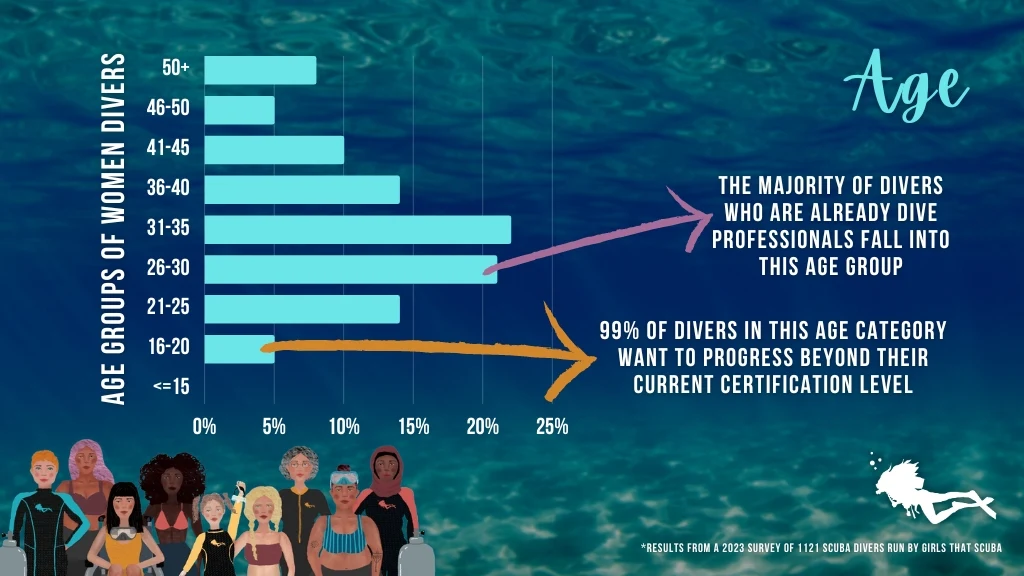
The majority of respondents who are already professional scuba divers are in the 26-30 age group.
Only 1% of 16-20 year old participants said they didn’t intend to go beyond their current diving level. This suggests that younger divers want to progress in the dive world, but are unsure how. This age range had plenty of suggestions about how the dive industry could be more accessible for young people:
Diving equivalents of scholarships for students (high school and college level) to allow them to be able to take courses and dive with financial aid and unaccompanied minor safety.
Diving is such a wonderful sport and I just wish it was more accessible for those who can’t afford as in Australia it can be quite expensive. If there was an option to spread the word of this fantastic activity maybe funds could be raised to help.
I think that finding ways to help women feel and be safe when traveling (especially with groups containing mostly men) would be very helpful.
More women & queer oriented role models and marketing.
Within participants over 50 years old, over 50% of them said they didn’t intend to take any more certifications above the level they already are. This was mostly due to being happy with their current experience.
Participants in the 46-50 year old category had the highest annual income, with 55% being in the $100,000 + category. 47% said they either don’t intend to, or aren’t sure if they will, go beyond their current diving level. Their reasonings include:
I have had children and they were going to have their PADI, so that has been my focus.
I don’t need to go any deeper than 40m. And I don’t need a certification to learn more.
Don’t want to become pro just enjoy!
Future Projects
Girls that Scuba are passionate about not only inspiring more women to start and continue diving, but to really dig in to the reasons behind the gender gap.
We’ve previously conducted a survey about pregnancy, motherhood and diving, and we continue to support dive organisations in their research. Please contact us if you have a study you’d like Girls that Scuba to be involved in.
Want to learn more?
If you’re interested in digging further into the data yourself, we have made the full results accessible for a limited time.
This is presented as an interactive dashboard, which allows you to narrow down responses to specific groups. There are 3 pages, which can be navigated through using the left and right arrows at the bottom of the screen.
- Page 1 is an overview of all the demographic information. Page 2 shows information about divers’ intentions to progress past their current certification. Page 3 refers to divers’ intentions to pursue a professional path.
- Click on an answer in any question to narrow down to just that group of respondents. Click the same answer again to return to all responses.
- You can select multiple groups by holding shift and clicking multiple answers.
- On page 2 and 3, groups can be narrowed down using the dropdown menus.
For any further questions relating to this data, please contact us on [email protected]

